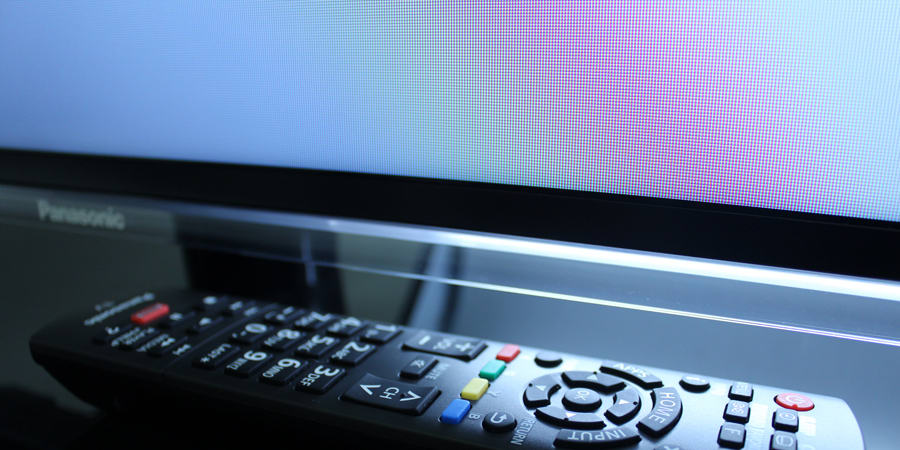Pros
Cons
Overview
Of course, these TVs can't perform all the top-tier tricks; action scenes won't blast forth in 3D majesty, and the design schemes are rather basic, for instance. E60 buyers will also miss out on flagship perks like Panasonic's Touch Pad Controller and voice control. But the fact is, this is a huge TV with fair performance, and it won't beat your billfold to smithereens.
Design
TVs this big don't really need showboat ensembles.
The E60 doesn't need a gaudy getup. The smallest size in this series is 42 inches, which isn't remarkably large, but from there, these TVs are 50 inches and up: Displays this large can look great without the glitz.
A lean, black bezel quietly traces the borders of the TV, framing its picture quite nicely. Supporting things from below is a simple, shiny plastic base. A clear plastic strip courses along the lowermost edge; it has an attractive look, but it's quite angular and sharp, so it was very uncomfortable to hold as we lugged it from its packaging, and then from room to room. Yet for a 50-inch TV, this one is very lightweight—45 pounds with the stand. Overall, this isn't the most eye-catching design scheme, but the restrained, minimalist approach is ultimately a winning one, especially given the the grand size of this panel.
Depending on where you station your TV, you may struggle a bit with connections. For example, all three HDMI ports face out on the back left side, so if you wall mount this display, that will prove awkward. In that same position, users will also find composite/component ports, an antenna hookup, and ethernet (LAN) port, and a digital audio out. To round out these options, two USB ports are easily accessible, facing out on the left side.
{{photo_gallery "design"}}
Features
A fair value, but functionality suffers for it
While the E60 series does feature Panasonic's smart platform, Viera Connect, it's missing many of the high-end goodies that the flagship models carry. For example, the Touch Pad Controller that enables mouse-like actions and voice commands is not included. Without this tool, owners of the E60 are left to languish online with nothing but a traditional remote control—squishy, non-backlit keys and all. And that's saying a lot: Without an agile way to get around a webpage, or a fast method of typing, users will come to hate internet browsing, Twitter, Facebook, and the like. Sharing is fairly easy, though. By enabling due settings on your smartphone, and after downloading the Viera Remote2 app, a feature called Swipe & Share plays media on the E60 from your phone. Smooth functionality here is dependent on a strong WiFi connection, obviously.
Happily, Touch Pad Controller or not, there are some apps on this TV that users will love. Netflix, Amazon Instant, Hulu Plus, Vudu HD Movies, and YouTube are a click away, suiting all of your streaming needs. And if you want to take a peek at the news headlines, the Wall Street Journal app isn't a bad way to go.
For everything else, this is yet another smart-TV bust; the games are utter silliness and personal tools like clocks and calendars are just irritating versions of the sleek beauties you'll find on your smart phone or computer—so why bother? If you're still curious about this TV's smart platform, feel free to read more about Viera Connect here.
Regarding menu settings, users certainly have plenty to toy with, and layout is quite friendly. There are picture presets to choose from, such as Cinema and Vivid, but customizable settings are available, too. The usual suspects are on hand, like color temperature, back light, and brightness, and beyond these users will find gamma, white balance, and even color luminance and saturation. Experienced calibrators have plenty to play with here.
{{photo_gallery "features"}}
Performance
No gold stars for this TV's homework
While this TV certainly doesn't deliver holy-cow grade picture quality, it doesn't fall entirely flat either. Testing certainly had a number of downs, but we still enjoyed viewing this TV in real-world settings, and its speakers sounded great. We do wish it had performed better though, especially in terms of its color.
One of the areas of performance where the E60 really stumbled was color accuracy. Instead of delivering perfectly accurate, natural colors, this TV punches up its blues and underemphasizes its reds, so that these tones appear less-than-lifelike. Of course, some people won't mind or even notice these errors, but we test against an international standard—and this TV didn't measure up. Fortunately, though, the colors do transition from one hue to the next in a fairly smooth manner, so images will look polished and detailed.
As to the rest, we've noted smoother motion on TVs of this caliber before, and the motion processing settings don't offer much in the way of fine-tuning, yet regular viewing proved satisfying, so no real complaints in that department. The overall contrast ratio, which enables a display to better relay lifelike pictures, is quite healthy. This is a very bright TV, and while we wish it could get more into the inky blacks that make for truly winning quality, these darks will certainly do; in both windowless and sunny settings, the picture quality looks very attractive. Lastly, as with most LEDs, the E60 series does not have an enormous viewing angle, so be sure to sit front-and-center for the best results.
Last Look
Big TVs that won't batter your billfold like a flagship would
Not everyone can afford a company's top-of-the-line flagship model, so it's nice that Panasonic offers the E60 series, with its wide array of big displays. If you have giant TVs on the brain, but your billfold needs a break, the 50-inch E60 (MSRP $1149.99) can be found online for $1,000. Picture quality like this doesn't exactly make my heart skip a beat, but on a 50-inch display with ample streaming options and a tame going-rate, this is a solid value.
At the end of the day, if your heart yearns for dashing design, better smart features, flawless color, and 3D content, you'll want to send your piggy bank back to the trough and keep on shopping.
Overview
For those of you who find yourselves squinting with skepticism at our front page proclamations, the science page is here to show you the numbers. We collect our data with DisplayMate test patterns, using Konica Minolta's CS-200 chroma meter, and LS-100 luma meter.
Color
Mild color errors
When we test for color, we look at three aspects of performance: color gamut, color curves, and color temperature. The color gamut is simply a measure of how closely a TV can match the Rec. 709 international standard for HDTV color, and in this case, we aren't impressed; blues are notably oversaturated, lending a punchy, inorganic feel to the picture, while reds suffer the opposite trouble.
Curves, on the other hand, are a description of how well the colors transition from one hue to the next. Are gradations smooth? Do colors peak too soon, resulting in a loss of detail at their most luminous states? In the case of the E60 series, not really; even though blues ramp up from dark to light a bit more slowly than greens and reds, the transitions aren't too bumpy, and we certainly didn't note any issues with this during regular viewing.
Rounding out this area of performance is a look at the color temperature. For the most part, colors held an even measure at 6600º K, save at the darker point of the spectrum where two deviations occur; these visible temperature errors mean that viewers may see hints of orange or blue in areas of medium-dark and dark shadow, at times—nothing too severe.
{{photo_gallery "color"}}
Contrast
This TV showed us the light(s)
Contrast is an important thing to test on a TV because it indicates how capable the machine is in terms of displaying lifelike, detailed images. A television needs many shades of grey to capture depth and detail.
While the E60 series doesn't hold a "candela" to some of Panasonic's 2013 big boys, like the VT60, we still enjoyed our time with the 50-inch model. This TV stooped into the dark spectrum with a black reading of 0.12 cd/m2 and leapt up in luminance with a dazzling level of 319.50 cd/m2 . The black level doesn't impress anyone here, though it will do; what really saves it is that blinding luminance reading, which kicks the overall contrast ratio to a healthy 2685:1.
{{photo_gallery "contrast"}}
Viewing Angle
Not as poor as on some LEDs, but still not great
To test a television's viewing angle, we measure its contrast ratio from a 90º, front-and-center position. Then we compare that reading to ones we take as we move in increments along an arc, and when the contrast drops below 50% of its original point, the television has reached the extent of its passable viewing angle.
In this case, we measured a total viewing angle of 55º, or 27.5º to either side of the center of the panel. This is significantly worse than what you will find on most plasmas, due to differences in design, but for an LED, we've certainly seen much worse.
{{photo_gallery "viewing"}}
Meet the tester
Virginia is a former Managing Editor at Reviewed.com. She has a background in English and journalism. Away from the office, Virginia passes time with dusty books & house cats.
Checking our work.
Our team is here to help you buy the best stuff and love what you own. Our writers, editors, and experts obsess over the products we cover to make sure you're confident and satisfied. Have a different opinion about something we recommend? Email us and we'll compare notes.
Shoot us an email

